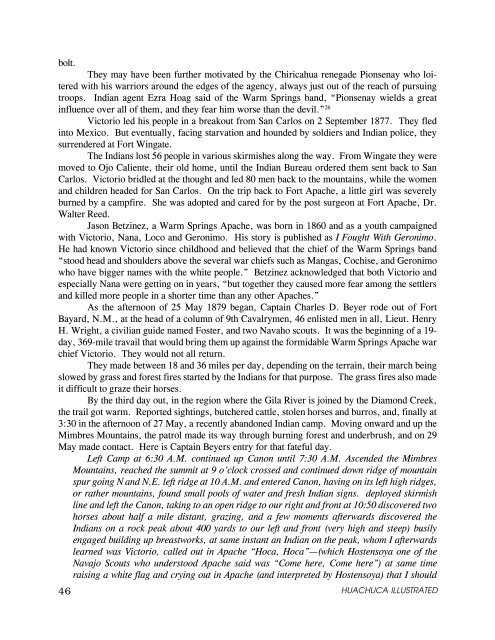Apache Campaigns - Fort Huachuca - U.S. Army
Apache Campaigns - Fort Huachuca - U.S. Army
Apache Campaigns - Fort Huachuca - U.S. Army
You also want an ePaper? Increase the reach of your titles
YUMPU automatically turns print PDFs into web optimized ePapers that Google loves.
olt.<br />
They may have been further motivated by the Chiricahua renegade Pionsenay who loitered<br />
with his warriors around the edges of the agency, always just out of the reach of pursuing<br />
troops. Indian agent Ezra Hoag said of the Warm Springs band, “Pionsenay wields a great<br />
influence over all of them, and they fear him worse than the devil.” 26<br />
Victorio led his people in a breakout from San Carlos on 2 September 1877. They fled<br />
into Mexico. But eventually, facing starvation and hounded by soldiers and Indian police, they<br />
surrendered at <strong>Fort</strong> Wingate.<br />
The Indians lost 56 people in various skirmishes along the way. From Wingate they were<br />
moved to Ojo Caliente, their old home, until the Indian Bureau ordered them sent back to San<br />
Carlos. Victorio bridled at the thought and led 80 men back to the mountains, while the women<br />
and children headed for San Carlos. On the trip back to <strong>Fort</strong> <strong>Apache</strong>, a little girl was severely<br />
burned by a campfire. She was adopted and cared for by the post surgeon at <strong>Fort</strong> <strong>Apache</strong>, Dr.<br />
Walter Reed.<br />
Jason Betzinez, a Warm Springs <strong>Apache</strong>, was born in 1860 and as a youth campaigned<br />
with Victorio, Nana, Loco and Geronimo. His story is published as I Fought With Geronimo.<br />
He had known Victorio since childhood and believed that the chief of the Warm Springs band<br />
“stood head and shoulders above the several war chiefs such as Mangas, Cochise, and Geronimo<br />
who have bigger names with the white people.” Betzinez acknowledged that both Victorio and<br />
especially Nana were getting on in years, “but together they caused more fear among the settlers<br />
and killed more people in a shorter time than any other <strong>Apache</strong>s.”<br />
As the afternoon of 25 May 1879 began, Captain Charles D. Beyer rode out of <strong>Fort</strong><br />
Bayard, N.M., at the head of a column of 9th Cavalrymen, 46 enlisted men in all, Lieut. Henry<br />
H. Wright, a civilian guide named Foster, and two Navaho scouts. It was the beginning of a 19day,<br />
369-mile travail that would bring them up against the formidable Warm Springs <strong>Apache</strong> war<br />
chief Victorio. They would not all return.<br />
They made between 18 and 36 miles per day, depending on the terrain, their march being<br />
slowed by grass and forest fires started by the Indians for that purpose. The grass fires also made<br />
it difficult to graze their horses.<br />
By the third day out, in the region where the Gila River is joined by the Diamond Creek,<br />
the trail got warm. Reported sightings, butchered cattle, stolen horses and burros, and, finally at<br />
3:30 in the afternoon of 27 May, a recently abandoned Indian camp. Moving onward and up the<br />
Mimbres Mountains, the patrol made its way through burning forest and underbrush, and on 29<br />
May made contact. Here is Captain Beyers entry for that fateful day.<br />
Left Camp at 6:30 A.M. continued up Canon until 7:30 A.M. Ascended the Mimbres<br />
Mountains, reached the summit at 9 o’clock crossed and continued down ridge of mountain<br />
spur going N and N.E. left ridge at 10 A.M. and entered Canon, having on its left high ridges,<br />
or rather mountains, found small pools of water and fresh Indian signs. deployed skirmish<br />
line and left the Canon, taking to an open ridge to our right and front at 10:50 discovered two<br />
horses about half a mile distant, grazing, and a few moments afterwards discovered the<br />
Indians on a rock peak about 400 yards to our left and front (very high and steep) busily<br />
engaged building up breastworks, at same instant an Indian on the peak, whom I afterwards<br />
learned was Victorio, called out in <strong>Apache</strong> “Hoca, Hoca”—(which Hostensoya one of the<br />
Navajo Scouts who understood <strong>Apache</strong> said was “Come here, Come here”) at same time<br />
raising a white flag and crying out in <strong>Apache</strong> (and interpreted by Hostensoya) that I should<br />
46<br />
HUACHUCA ILLUSTRATED

















